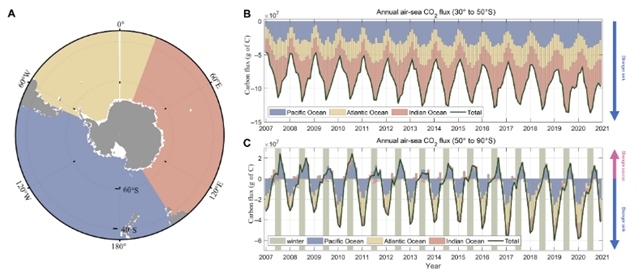近日,中国科学院南京地理与湖泊研究所施坤团队报道了南大洋冬季二氧化碳的来源被大大低估。2025年11月7日出版的《科学进展》杂志发表了这项成果。
由于冬季观测的稀少,南大洋碳通量的大小和控制机制仍然高度不确定。
研究组将卫星光探测和测距(LIDAR)测量与机器学习相结合,以评估2007年至2020年间南大洋空气-海洋二氧化碳通量。结果发现,在以前的研究中,50°S以南的CO2脱气被低估了高达40%。在中纬度南大洋(30°~ 50°S)作为碳汇增强的同时,高纬度区域(50°~ 90°S)表现出南环模(SAM)调制的吸收和释放之间的交替。
海气CO2分压差(ΔpCO2)越来越多地支配着通量变异性,而不是风驱动的传输速度。研究组提出了一个包含三个纬度环的框架,它们具有不同的pCO2控制:(i)南极(盐度/海冰),(ii)极锋(大气CO2/叶绿素)和(iii)亚极地(海面温度/CO2)。这些发现强调了冬季过程的关键作用,需要全年观测来了解南大洋全球碳循环的影响。
附:英文原文
Title: Substantially underestimated winter CO2 sources of the Southern Ocean
Author: Siqi Zhang, Peng Chen, Kelsey Bisson, Cédric Jamet, Paolo Di Girolamo, Davide Dionisi, Yongxiang Hu, Zhenhua Zhang, Kun Shi, Delu Pan
Issue&Volume: 2025-11-07
Abstract: The size and control mechanism of the Southern Ocean’s carbon fluxes remain highly uncertain due to sparse winter observations. Here, we integrate satellite light detection and ranging (LIDAR) measurements with machine learning to assess the Southern Ocean air-sea CO2 fluxes between 2007 and 2020. We reveal that CO2 outgassing south of 50°S was underestimated by up to 40% in previous studies. While the midlatitude Southern Ocean (30° to 50°S) strengthens as a carbon sink, the high-latitude region (50° to 90°S) shows Southern Annular Mode (SAM)–modulated alternation between uptake and outgassing. The air-sea CO2 partial pressure difference (ΔpCO2) increasingly dominates flux variability over wind-driven transfer velocity. We propose a framework involving three latitudinal loops with differing pCO2 controls: (i) Antarctic (salinity/sea ice), (ii) polar front (atmospheric CO2/chlorophyll), and (iii) subpolar (sea surface temperature/CO2). The findings underscore the winter processes’ critical role and necessitate year-round observations to understand Southern Ocean’s global carbon cycle impact.
DOI: aea0024
Source: https://www.science.org/doi/10.1126/sciadv.aea0024

